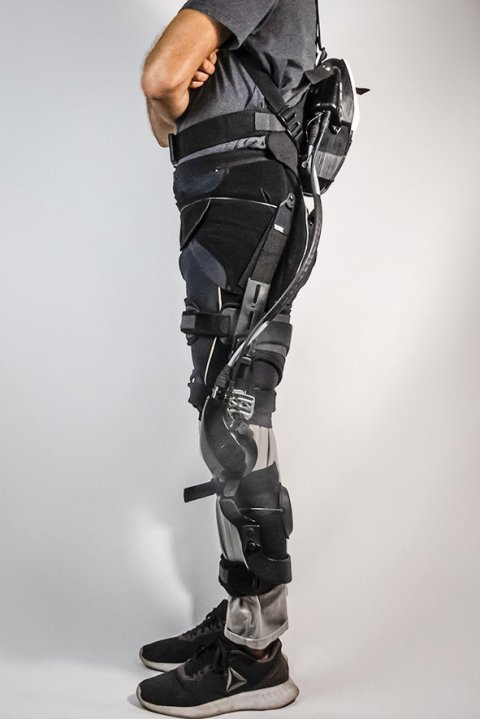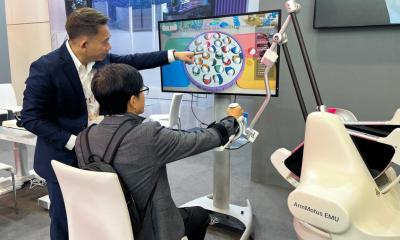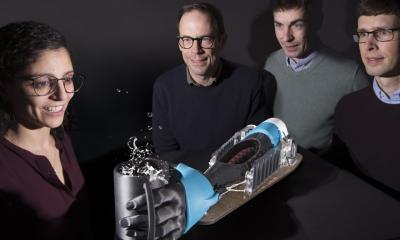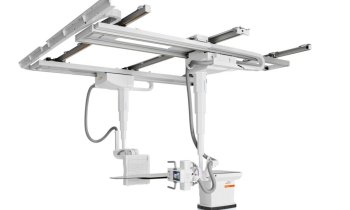Article • Affordable and widely accessible
Robotics applied in support of patient wellbeing
Keeping technology simple and affordable is key in helping patients to fully benefit from robotic systems, according to a leading expert in the field.
Report: Mark Nicholls

Image source: RWTH Aachen; © M. Fritschi
While expensive and complex systems have been developed, Professor Heike Vallery believes the full potential of robotics in patient care will only be realised when they become more affordable and widely accessible. She also underlines the importance of the sector being confident enough to ‘share failures’ to advance knowledge of what works and what does not work in terms of robotics for patients.
Robotic technology is advancing healthcare over a range of areas in the operating theatre with RAMIS (robotically-assisted minimally invasive surgery), in terms of transport and moving products within hospitals and pharmacies, and patient rehabilitation and even preventive healthcare. Soft robotic technology and improved sensors are driving this.
Complex technology
Vallery, who was among the keynote speakers in the 40th ICRA (International Conference on Robotics and Automation) in London, is an expert in robotics to improve patient mobility, particularly those who have motor-impaired conditions or suffered a stroke. With advances in robot technology in healthcare explored during the five-day event alongside innovation in robotics in manufacturing and domestic settings, her presentation “Subtractive design of robotics to empower individuals with motor impairments” highlighted the need for simpler solutions.
Often, devices are proposed that are overly complex and expensive, accessible to only a very few people, but many of the key functionalities that help users can be done with simpler systems
Heike Vallery
Speaking to Healthcare in Europe ahead of the event, she said: ‘When applying robotics with the aim to empower motor-impaired individuals, often highly complex technology results, which hinders implementation in daily life.’ She underlined the importance of achieving functionality that really makes a difference for the individual. Recent results from experiments with robotic body-weight support systems surprisingly challenged assumptions on what humans need or prefer in order to walk or balance better.
Her team discovered that simpler solutions were just as effective and even favoured by patients over complex equipment. ‘This demonstrates the importance of engaging with users at an early stage and of distilling key requirements,’ said Vallery. ‘Often, devices are proposed that are overly complex and expensive, accessible to only a very few people, but many of the key functionalities that help users can be done with simpler systems.’ The devices her team is working on include cable robot systems with harness, pulleys, and motors to support human movement, or prosthetic legs for elderly users who have trouble standing up.

© ICRA
She strongly advocates the importance of research teams sharing setbacks as well as successes in their different approaches. ‘We tested a prosthetic leg that users were not putting weight on and it actually made it harder for them to stand up or sit down,’ said Vallery. ‘We analysed how it went wrong and observed that we had disregarded the ankle, the foot was too rigid. We were augmenting the knee but found it does not help if you do not support the ankle.’ She pointed out that publishing on areas where things did not always go according to plan and sharing lessons learned creates a healthier research environment and ultimately advances the field.
The emphasis with patient robotics is now seeing researchers and companies focusing on simpler devices for people’s homes. ‘We are moving from devices costing several hundred thousand euros and only affordable to large rehabilitation centres to very simple technology,’ she explained.
The sector is also acknowledging that margins of improvement after a stroke or other neurological condition can often be small. ‘But sometimes people can get over a certain threshold that allows them to functionally use certain limbs again and that is the reason why we make these types of devices.’ However, she also noted how the administrative burden from new medical device regulations is impacting smaller players in the market. Her career at Delft has centred on robot-assisted rehabilitation and prosthetic legs in collaboration with clinicians and industry partners, and with a move to RWTH Aachen, Germany, she will continue the focus on simpler robotic technology.
Keynote session
The keynote session at ICRA on healthcare highlighted how robot technologies can take on different aspects of patient care against a backdrop of aging populations, increasing healthcare costs, and a shortage of healthcare professionals. The development of specialized sensors, magnetic positioning, machine learning algorithms, highly-flexible snakearms robots, and intelligent decision-making systems that enable robots to safely carry out complex tasks within a healthcare setting are accelerating the advances.

Image source: Scuola Superiore Sant’Anna
Wearable robotics are being adapted from patient rehabilitation into “prehabilitation” to help people stay active for longer. Simona Crea, Assistant Professor at Scuola Superiore Sant’Anna (SSSA) in Pisa, Italy, explained that they are also being applied in industrial settings, specifically with preventive healthcare in mind.
An important area of development is to make walking and locomotion activities, such as moving from sitting to standing, easier. A focus of her work is on developing robotically-supported exoskeletons for patients who spend higher energy when walking, such as those with diabetes, who may undergo lower-limb amputation when the disease progresses too much. ‘Such patients typically have high metabolic consumption when they walk, so walking is very difficult,’ said Crea. ‘They tend to walk much slower.’ Making walking easier for these patients may result in a more active lifestyle and therefore a reduced risk to develop complications due to sedentary life. The powered exoskeleton gives them ‘an additional burst of energy.’
Physical training
The technology also has value in the rehabilitation of stroke patients, but, in parallel to developing systems that are more comfortable to use, she stressed the importance of making devices lighter yet without sacrificing mechanical power. ‘That is a key design challenge,’ added Crea, who co-leads the wearable robotics laboratory of the SSSA’s BioRobotics Institute.
‘At the same time, we need a device that understands, in real time, what the user’s intention is in moving.’ She uses the phrase ‘prehabilitation’ to explain how wearable robotics can help ‘enhance and enrich’ the walking experience for older people and support their physical training. ‘For example, this could be training at higher velocities, volumes, or workloads without significantly increasing the metabolic consumption of the user.’
Worker wellbeing
She advocates a role for ‘wearable robots for sustainable aging,’ which she outlined in her presentation to the ICRA congress. Wearable robots are being designed for industrial applications, but even here they also have a healthcare application. As Crea explained: ‘They
can be used as tools that prevent development of musculoskeletal injuries or disorders at work. There is momentum in this field of prevention.
‘The technology is for the wellbeing of the worker, to preserve and sustain the musculoskeletal system by reducing the biomechanical load on specific joints.’
Profiles:
Heike Vallery graduated in 2004 with honors from RWTH Aachen University with a Dipl.-Ing. degree in Mechanical Engineering. Since then, she has been working on robot-assisted rehabilitation and prosthetic legs. In 2009, she earned her Dr.-Ing. from the Technische Universität München and then continued her academic career at ETH Zürich, Khalifa University and TU Delft. Today, she is a full professor at RWTH Aachen and TU Delft, and also holds an honorary professorship at Erasmus MC in Rotterdam. Her current research focuses on developing minimalistic and unconventional concepts to support human gait and balance.
Simona Crea is a tenure-track Assistant Professor at Scuola Superiore Sant’Anna (SSSA) and co-leads the SSSA wearable robotics laboratory. Her background is in Biomedical Engineering and her research experience is in the field of wearable robotics for rehabilitation, assistance, and augmentation of human motor functions.
12.02.2024











